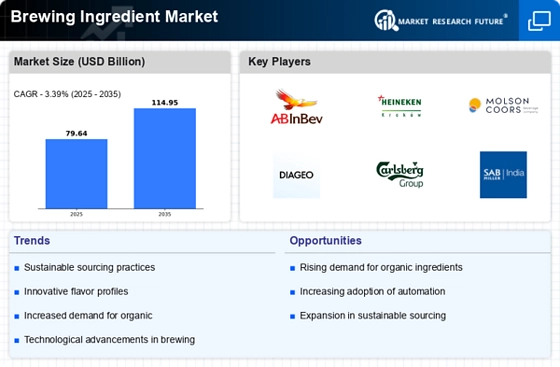Regulatory Changes and Compliance
The Brewing Ingredient Market is significantly influenced by regulatory changes and compliance requirements. Governments are increasingly implementing stringent regulations regarding ingredient sourcing, labeling, and safety standards. These regulations aim to ensure consumer safety and promote transparency within the industry. For instance, the introduction of new labeling requirements for allergens and additives has prompted breweries to reassess their ingredient sourcing and production processes. Compliance with these regulations can be challenging, particularly for smaller breweries. However, it also presents an opportunity for ingredient suppliers to offer compliant products that meet these evolving standards. As regulations continue to evolve, the Brewing Ingredient Market must adapt to maintain compliance and consumer trust.
Sustainability Initiatives in Brewing
Sustainability initiatives are becoming increasingly prominent within the Brewing Ingredient Market. Breweries are adopting eco-friendly practices, such as sourcing organic ingredients and implementing waste reduction strategies. This shift is largely driven by consumer awareness and demand for sustainable products. A recent survey indicated that over 70% of consumers prefer brands that demonstrate environmental responsibility. Consequently, suppliers of brewing ingredients are responding by offering organic and sustainably sourced options. This trend not only aligns with consumer values but also enhances brand loyalty among environmentally conscious consumers. As sustainability becomes a core focus, the Brewing Ingredient Market is likely to see a rise in the availability of eco-friendly ingredients.
Technological Advancements in Brewing
The Brewing Ingredient Market is experiencing a notable transformation due to technological advancements. Innovations in brewing equipment and processes enhance efficiency and product quality. For instance, the adoption of automated brewing systems allows for precise control over fermentation and ingredient usage, leading to consistent flavor profiles. Furthermore, advancements in ingredient extraction techniques, such as cryogenic grinding, improve the quality of hops and malt. According to industry reports, the market for brewing technology is projected to grow at a compound annual growth rate of 6.5% over the next five years. This growth indicates a strong demand for high-quality brewing ingredients, as breweries seek to differentiate their products in a competitive landscape.
Increasing Demand for Specialty Ingredients
The Brewing Ingredient Market is witnessing a surge in demand for specialty ingredients, driven by consumer preferences for unique flavors and experiences. Craft breweries, in particular, are experimenting with a diverse range of ingredients, including exotic hops, specialty malts, and adjuncts like fruits and spices. This trend is reflected in the rising number of craft breweries, which has increased by approximately 20% in the last three years. As consumers seek out distinctive and innovative brews, the demand for specialty ingredients is expected to continue its upward trajectory. This shift not only influences ingredient sourcing but also encourages suppliers to diversify their offerings to meet the evolving tastes of consumers.
Growth of E-commerce in Ingredient Distribution
The rise of e-commerce is reshaping the distribution landscape of the Brewing Ingredient Market. Online platforms are increasingly becoming a preferred channel for breweries to source their ingredients, offering convenience and a wider selection. This trend is particularly beneficial for small and independent breweries that may not have access to traditional distribution channels. E-commerce platforms enable these breweries to connect directly with ingredient suppliers, facilitating better pricing and availability. Recent data suggests that online sales of brewing ingredients have increased by approximately 30% in the past year. As e-commerce continues to expand, it is likely to play a crucial role in the future distribution strategies of the Brewing Ingredient Market.


















Leave a Comment